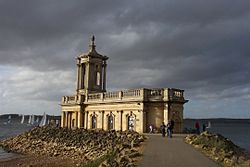Normanton, Rutland: Difference between revisions
Created page with "{{Infobox town |name =Normanton |county=Rutland |picture=Normanton church clouds.jpg |picture caption=St Matthew's Church, now de-consecrated |population = 26 |census year=200..." |
m →top: ioe -> nhle, replaced: {{IoE|187010 → {{NHLE|1177773 |
||
| Line 22: | Line 22: | ||
In the 1970s much of the parish was flooded by the construction of the [[Rutland Water]] reservoir. | In the 1970s much of the parish was flooded by the construction of the [[Rutland Water]] reservoir. | ||
St Matthew's Church is a Grade-II-listed building, built in classical style. The tower and the western portico were built by Thomas Cundy Jr between 1826 and 1829, based on the design of St John's, Smith Square in [[Westminster]], while the nave and apse were constructed in 1911, by J. B. Gridley of [[London]].<ref>{{ | St Matthew's Church is a Grade-II-listed building, built in classical style. The tower and the western portico were built by Thomas Cundy Jr between 1826 and 1829, based on the design of St John's, Smith Square in [[Westminster]], while the nave and apse were constructed in 1911, by J. B. Gridley of [[London]].<ref>{{NHLE|1177773}} Church of St Matthew, Normanton</ref> The building was once the private chapel for the Normanton Estate, but it was de-consecrated in 1970, and was to have been demolished as part of the reservoir construction, as its floor was below the proposed water level. Following a public outcry, the lower half was filled with stone and rubble, and a concrete cap constructed just below the level of the windows. An embankment was built around the church leaving it a prominent feature on the water's edge.<ref>{{cite web |url=http://www.lhi.org.uk/docs/oyfs_rutlandwater.pdf |title=The Heritage of Rutland Water |publisher=Rutland Local History & Record Society |page=3 |accessdate=2011-03-17}}</ref> The structure formerly housed a museum recording the history of Rutland Water, which is now located in the visitor centre. The structure is now used as a venue for civil weddings and concerts. | ||
==Outside links== | ==Outside links== | ||
Latest revision as of 08:48, 19 September 2019
| Normanton | |
| Rutland | |
|---|---|
 St Matthew's Church, now de-consecrated | |
| Location | |
| Grid reference: | SK933060 |
| Location: | 52°38’38"N, -0°37’19"W |
| Data | |
| Population: | 26 (2001[1]) |
| Post town: | Oakham |
| Dialling code: | 01572 |
| Local Government | |
| Parliamentary constituency: |
Rutland and Melton |
Normanton is a village and civil parish on the eastern shore of Rutland Water in the county of Rutland. The population remained less than 100 at the 2011 census and was included in the civil parish of Edith Weston.

Normanton Hall was a seat of the Earls of Ancaster and an important centre of their estates. The stable block of their hall is now Normanton Park hotel. In the 18th century the village was cleared to make a park for the estate of the Heathcote family with the population mainly re-housed in Empingham.
In the 1970s much of the parish was flooded by the construction of the Rutland Water reservoir.
St Matthew's Church is a Grade-II-listed building, built in classical style. The tower and the western portico were built by Thomas Cundy Jr between 1826 and 1829, based on the design of St John's, Smith Square in Westminster, while the nave and apse were constructed in 1911, by J. B. Gridley of London.[2] The building was once the private chapel for the Normanton Estate, but it was de-consecrated in 1970, and was to have been demolished as part of the reservoir construction, as its floor was below the proposed water level. Following a public outcry, the lower half was filled with stone and rubble, and a concrete cap constructed just below the level of the windows. An embankment was built around the church leaving it a prominent feature on the water's edge.[3] The structure formerly housed a museum recording the history of Rutland Water, which is now located in the visitor centre. The structure is now used as a venue for civil weddings and concerts.
Outside links
| ("Wikimedia Commons" has material about Normanton, Rutland) |
- Rutland Website – Normanton
- 'Normanton church opens for weddings' photo gallery from BBC Radio Leicester
References
- ↑ "Rutland Civil Parish Populations". Rutland County Council. 2001. http://www.rutland.gov.uk/ppimageupload/Image27657.PDF. Retrieved 18 March 2009.
- ↑ National Heritage List 1177773: Normanton, Rutland Church of St Matthew, Normanton
- ↑ "The Heritage of Rutland Water". Rutland Local History & Record Society. p. 3. http://www.lhi.org.uk/docs/oyfs_rutlandwater.pdf. Retrieved 2011-03-17.

This Rutland article is a stub: help to improve Wikishire by building it up.
